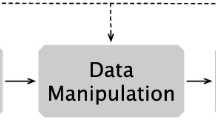Abstract.
In data mining, the usefulness of a data pattern depends on the user of the database and does not solely depend on the statistical strength of the pattern. Based on the premise that heuristic search in combinatorial spaces built on computer and human cognitive theories is useful for effective knowledge discovery, this study investigates how the use of self-organizing maps as a tool of data visualization in data mining plays a significant role in human–computer interactive knowledge discovery. This article presents the conceptual foundations of the integration of data visualization and query processing for knowledge discovery, and proposes a set of query functions for the validation of self-organizing maps in data mining.
Similar content being viewed by others
Author information
Authors and Affiliations
Additional information
Received 1 November 1999 / Revised 2 March 2000 / Accepted in revised form 20 October 2000
Rights and permissions
About this article
Cite this article
Wang, S., Wang, H. Knowledge Discovery Through Self-Organizing Maps: Data Visualization and Query Processing. Knowledge and Information Systems 4, 31–45 (2002). https://doi.org/10.1007/s10115-002-8192-7
Issue Date:
DOI: https://doi.org/10.1007/s10115-002-8192-7




